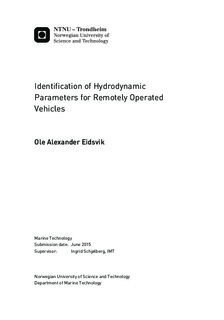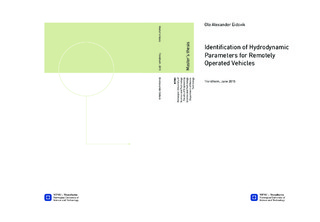| dc.description.abstract | The hydrodynamic parameters that characterize the behaviour of a general work class Remotely Operated Vehice(ROV) are evaluated. This is done by deriving the equation of motion for an ocean vessel moving in 6 degrees of freedom. The equation of motion is then applied to a general work class ROV. The resulting hydrodynamic parameters are then evaluated and the two main hydrodynamic quantities of interest is shown to be the added mass and hydrodynamic damping. These two quantities are in combination with the rigid body mass and restoring forces the main contributors that dictates the motion of a ROV in water.
Different methods for obtaining the hydrodynamic parameters are discussed. Already established, but also new methods are evaluated. These include experimental, numerical, analytical and empirical methods.
A complete procedure for obtaining the hydrodynamic parameters is suggested. The procedure includes an empirical method which uses basic empirical coefficients and already established theory. Additional new theory is introduced where lack of existing literature made it necessary. The empirical method is tested on 5 ROVs with completely different geometries. The procedure also consists of an experimental method. The experimental method is based on towing/rotation tank trials, where the ROV is towed or rotated to record the hydrodynamic forces acting on the ROV at different speeds. The experimental setup is designed to be low cost and easy to perform even with limited means. The experimental procedure is tested on ROV Neptunus and VideoRay Pro-4 which are two small ROVs with very different characteristics.
Computational Fluid Dynamics(CFD) and potential flow theory is used to verify the two methods. This is done by comparing the numerical results to the obtained experimental and empirical estimates.
The added mass estimates are compared to results produced by WADAM(Wave Analysis by Diffraction and Morison Theory) which is a program in the Sesam software package that utilizes the panel method to estimate hydrodynamic coefficients using potential flow theory. The results from the empirical added mass estimates shows good correspondence with the reference results. The relative difference is for the translational degrees of freedom in the range of 10 to 20% and for the rotational degrees of freedom in the range of 30-100%. These results show that there are room for improvements, but based on the basic nature of the method and complex shapes of the ROVs it still provides results that can be deemed satisfactory.
The damping forces are verified by using SolidWorks Flow Simulation which is a CFD program incorporated in the SolidWorks program package. The empirical and experimental estimates shows promising results with the exception of the experimental values obtained for VideoRay Pro-4 where the experimental damping is substantially larger than both CFD and empirical estimates. The empirical method generally overestimates the damping, but usually lies in the correct range. The experimental method shows for ROV Neptunus very good correspondence with regards to the CFD results.
The procedure described presents a robust way of determining the hydrodynamic coefficients of a ROV with a relative uncertainty of less than approximately 100% for a number of different ROVs with completely different characteristics. The method has great room for improvement, especially the experimental procedure can be improved drastically as some results are very accurate while other results shows great deviation with regards to the referenced values. | |

